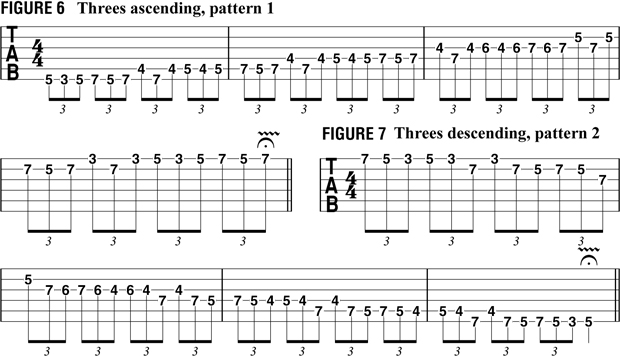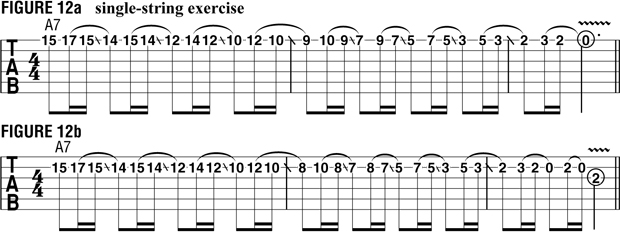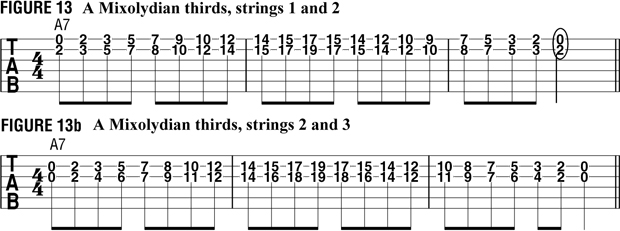In Deep: Applying Modes to Improvised Solo Ideas, Part 2

In last month’s column, we explored a variety of ways to apply a modal approach to improvisation, with specific focus on minor tonalities and building from lines based on the E minor pentatonic scale (E G A B D) to ones based on the E Dorian mode (E Fs G A B Cs D), as well as E Dorian’s “parent” scale, D major (D E Fs G A B Cs).
We also broke things down to the D major scale’s five-tone subset, D major pentatonic (D E Fs A B) and its relative minor equivalent, B minor pentatonic (B D E Fs A). In this edition of In Deep, I will shift the focus from minor to major with an exploration of one of the most commonly used major modes, Mixolydian.
The broad appeal and usage of the Mixolydian mode is based on the prevalence of dominant-seventh chords in such a wide variety of musical styles, specifically blues, rock and country. If you are familiar with the major scale, understanding Mixolydian will be very easy, as there is only one scale degree that differs between the major scale and the Mixolydian mode.


FIGURE 1 illustrates the A major scale played in fourth position, with the intervallic structure indicated beneath the notation. The A major scale consists of the notes A B Cs D E Fs Gs. Intervallically, this scale is spelled 1 (root), ma2 (major second), ma3 (major third), 4, 5, ma6 (major sixth), ma7 (major seventh). Mixolydian differs from the major scale in the seventh scale degree: in Mixolydian, it is lowered one half step from the major seventh to the dominant, or “flatted,” seventh, (“f7”). FIGURE 2 shows A Mixolydian in fourth position, again with each note’s harmonic function indicated.

The best way to get a handle on A Mixolydian in this position is to drill on it, playing it up and down many times, as shown in FIGURE 3. As always, begin slowly, with care and attention to precision, so that the sound and attack of each note will be even, smooth and consistent.

Another great exercise is to play the notes of the mode in descending pairs, as depicted in FIGURE 4. Here, I begin on the A root note, the first scale degree, and then play G, the next lower note in the scale. This is followed by B, the second scale degree, followed by the next lower note in the scale, A. This pattern then continues all the way through to the highest notes of the mode available in this position.

Once you have a handle on this exercise, try the one shown in FIGURE 5, which is the inverse of FIGURE 4. Starting on the highest root note in this position, I follow it with the next higher note in the scale. I then begin one note lower and repeat the process, and then carry this formula in a descending manner through the rest of the scale degrees of A Mixolydian in this position.

Most of you are probably well familiar with scale exercises based on groups of three, four, five, six or more notes. FIGURE 6 offers an exercise played in eighth-note triplets based on A Mixolydian. In each three-note “cell,” a scale degree is played and followed by the next lower scale degree, then a return to the original starting note. The formula ascends one scale degree at a time through A Mixolydian in fourth position. FIGURE 7 is also based on eighth-note triplets, but the melodic shape of each cell differs from FIGURE 6 in that each eighth-note triplet consists of three scale degrees that progressively descend. It begins B-A-G, followed by A-G-Fs, G-Fs-E, Fs-E-D, etc.

A very cool way to create a “Mixolydian” sound is to alter the minor pentatonic scale by one note. FIGURE 8a illustrates A minor pentatonic (A C D E G), as played in fifth position in ascending and descending form. If we switch the minor third of A, C, to the major third, Cs, the result is a five-tone scale known as A dominant pentatonic, illustrated in FIGURE 8b. Play this scale up and down many times in order to memorize the fingering.

FIGURES 9–11 offer three different runs that utilize the A dominant pentatonic scale as its basis. Throughout FIGURE 9, I approach the major third, Cs, from below by using either a slide or a hammer-on. At the end of bar 1 into bar 2, I introduce the notes of an Em7 arpeggio (E G B D) as a melodic superimposition over A7, working back into an A Mixolydian sound with the ascending chromatic tones B-C-Cs.


Another twist on the superimposed arpeggio approach kicks off FIGURE 10, as the notes of an Fsm7 arpeggio (Fs A Cs E) are played in descending order, followed by an ascending Em7 arpeggio (E G B D). This in turn is followed by more conventional A dominant pentatonic phrases that clearly related to the A7 “home” chord.

A great exercise for memorizing any scale is to play it up and down a single string across the entire length of the fretboard. FIGURES 12a and 12b offer two noodle-y legato licks based on eighth and 16th notes that descend the high E and B strings, respectively, with a liberal use of pull-offs used in combination with descending finger slides.


One of the most prevalent uses of the Mixolydian modality in both blues and R&B/soul is the incorporation of harmonized two-note phrases based on either thirds or sixths. Just as drilling the A Mixolydian mode up and down one string reaps many rewards, so does applying the approach to two-note pairs of thirds and sixths up and down a pair of strings. FIGURES 13a and 13b illustrated harmonized Mixolydian thirds in the key of A on the high E and B, and the B and G, strings, respectively. FIGURE 14 shows A Mixolydian played in sixths on the high E and G strings. Try moving the harmonized thirds and sixths to other adjacent and nonadjacent string pairs to gain a fuller understanding of A Mixolydian all over the fretboard.
Get The Pick Newsletter
All the latest guitar news, interviews, lessons, reviews, deals and more, direct to your inbox!
Guitar World Associate Editor Andy Aledort is recognized worldwide for his vast contributions to guitar instruction, via his many best-selling instructional DVDs, transcription books and online lessons. Andy is a regular contributor to Guitar World and Truefire, and has toured with Dickey Betts of the Allman Brothers, as well as participating in several Jimi Hendrix Tribute Tours.
“There are so many sounds to be discovered when you get away from using a pick”: Jared James Nichols shows you how to add “snap, crackle and pop” to your playing with banjo rolls and string snaps
Don't let chord inversions bamboozle you. It's simply the case of shuffling the notes around








![Joe Bonamassa [left] wears a deep blue suit and polka-dotted shirt and plays his green refin Strat; the late Irish blues legend Rory Gallagher [right] screams and inflicts some punishment on his heavily worn number one Stratocaster.](https://cdn.mos.cms.futurecdn.net/cw28h7UBcTVfTLs7p7eiLe.jpg)


